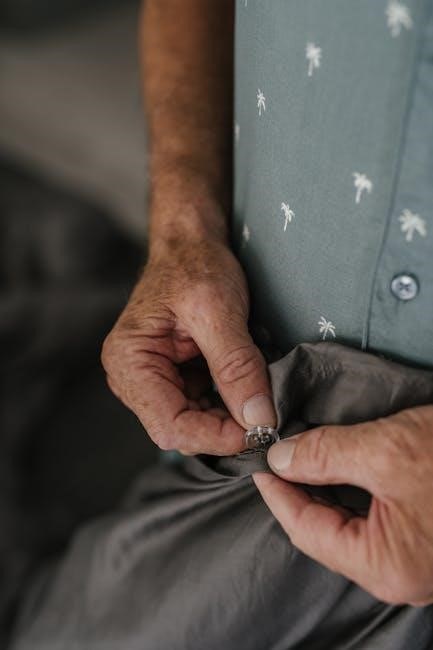Rotator cuff tendonitis is inflammation of the tendons in the shoulder, causing pain and limited mobility. It often results from overuse or injury, affecting daily activities. Early treatment with targeted exercises can alleviate symptoms and promote healing, emphasizing stretching and strengthening to restore shoulder function and prevent further damage.
What is Rotator Cuff Tendonitis?
Rotator cuff tendonitis is an inflammatory condition affecting the tendons of the rotator cuff muscles in the shoulder. These tendons, which connect muscles to bones, become irritated or swollen, often due to overuse, repetitive movements, or direct injury. The rotator cuff plays a crucial role in stabilizing the shoulder joint and enabling smooth movement. When tendonitis occurs, it can lead to pain, especially during activities like lifting, reaching, or overhead motions. The inflammation may also cause limited mobility and tenderness in the affected area. If left untreated, rotator cuff tendonitis can progress to more severe conditions, such as partial or complete tendon tears. Early intervention, including rest, ice therapy, and targeted exercises, is essential to reduce inflammation and restore shoulder function. Proper management can prevent further complications and improve quality of life for those affected.
Causes and Risk Factors
Rotator cuff tendonitis often arises from repetitive overhead movements, common in sports like swimming or baseball, and in jobs requiring frequent lifting. Aging is another major factor, as tendons naturally lose elasticity and become more prone to injury; Poor shoulder mechanics, such as improper form during exercises or muscle imbalances, can also contribute. Trauma, like a fall or sudden strain, may lead to acute cases. Additionally, individuals with pre-existing shoulder issues or those who engage in repetitive activities without proper rest are at higher risk. Factors like posture and equipment usage can exacerbate stress on the rotator cuff, increasing the likelihood of tendonitis. Understanding these causes and risk factors is crucial for developing effective prevention and treatment strategies to address the condition and enhance shoulder health.
Symptoms and Diagnosis
Rotator cuff tendonitis typically presents with pain in the shoulder, especially during overhead activities, reaching, or lifting. Pain may also occur at night or with specific movements like internal rotation. Limited range of motion and weakness in the affected arm are common symptoms. Diagnosis begins with a clinical examination, including physical tests such as the Hawkin’s test or Neer’s test, which assess pain and impingement. Imaging studies like MRI or ultrasound may be used to confirm the extent of tendon inflammation or rule out tears. Early diagnosis is critical to prevent progression to more severe conditions. Proper evaluation ensures a tailored treatment plan, often involving targeted exercises to alleviate symptoms and restore shoulder function. Recognizing these signs and seeking timely medical advice can significantly improve outcomes for individuals with rotator cuff tendonitis.

Understanding the Rotator Cuff
The rotator cuff is a group of four muscles and tendons surrounding the shoulder joint, providing stability and enabling movements like lifting, rotating, and overhead activities. Its proper function is essential for maintaining shoulder mobility and preventing injury.
Anatomy of the Rotator Cuff
The rotator cuff is a complex structure comprising four muscles and their associated tendons, which surround the shoulder joint to provide stability and enable a wide range of motion. The four muscles include the supraspinatus, infraspinatus, teres minor, and subscapularis. The supraspinatus is located at the top of the shoulder and helps in abduction, while the infraspinatus and teres minor are at the back, aiding in external rotation. The subscapularis is at the front, contributing to internal rotation and stabilization. These muscles work together to stabilize the humerus (upper arm bone) in the glenoid cavity, ensuring proper shoulder mechanics. The tendons of these muscles attach to the humerus, forming a cuff-like structure that protects the joint and facilitates movements such as lifting, rotating, and overhead activities. The integrity of the rotator cuff is crucial for maintaining shoulder function, and any inflammation or damage to these tendons can lead to conditions like tendonitis, significantly impacting mobility and comfort.
Functions of the Rotator Cuff Muscles
The rotator cuff muscles play a vital role in shoulder movement and stability. The supraspinatus initiates abduction, lifting the arm away from the body, while the infraspinatus and teres minor manage external rotation, rotating the arm outward. The subscapularis handles internal rotation, rotating the arm inward. Collectively, these muscles stabilize the humeral head within the glenoid cavity, preventing dislocation and enabling precise movements. They also work synergistically to control the arm during activities like throwing, lifting, and reaching overhead. Without proper function, everyday tasks become challenging, highlighting their importance in maintaining shoulder health and mobility. Dysfunction in these muscles can lead to pain and limited range of motion, often seen in conditions like tendonitis, emphasizing the need for targeted exercises to restore strength and function. Regular strengthening and stretching exercises can help prevent injuries and improve overall shoulder performance. Proper activation of these muscles is essential for optimal shoulder mechanics and injury prevention. This underscores the importance of understanding their roles in maintaining shoulder function and addressing any imbalances or weaknesses through appropriate rehabilitation strategies.

Exercises for Rotator Cuff Tendonitis
Targeted exercises, such as isometric holds, stretching, and strengthening movements using resistance bands or light weights, can improve shoulder strength and mobility. These exercises should be performed without pain and under professional guidance.
Stretching Exercises
Stretching exercises are essential for improving flexibility and reducing stiffness in the rotator cuff. One effective stretch is the doorway stretch, where you stand in a doorway with your arms overhead and gently press forward. Another is the cross-body stretch, where you bring one arm across your chest toward the opposite shoulder. These stretches help elongate the tendons and muscles, promoting better range of motion. It’s important to hold each stretch for 20-30 seconds and avoid bouncing, as this can cause further irritation. Regular stretching can alleviate tension in the rotator cuff, making daily activities more comfortable. Always perform stretches gently and without pain to ensure effectiveness and safety.
Strengthening Exercises
Strengthening exercises are crucial for rebuilding the rotator cuff muscles and improving shoulder stability. Common exercises include arm raises, where you lift your arm overhead or to the side, and shoulder rotations, which involve rotating your arm in small circles. Resistance bands or light weights can be incorporated to increase intensity. Performing prone rows on a bench strengthens the scapular muscles, while external rotations with a towel or band target the infraspinatus and teres minor muscles. These exercises should be done 2-3 times weekly, starting with low resistance and gradually increasing as strength improves. Proper form is essential to avoid further injury. Strengthening the rotator cuff muscles helps restore shoulder function, reduce pain, and prevent future tendonitis. Consistency and patience are key to achieving long-term benefits and maintaining shoulder health.
Isometric Exercises
Isometric exercises are a key component of rotator cuff rehabilitation, focusing on muscle contractions without joint movement. These exercises are ideal for initial stages of recovery, as they minimize stress on the tendon while improving strength and stability. A common isometric exercise is the shoulder external rotation hold, where the arm is pressed against a door frame for 5-10 seconds. Another effective exercise is the shoulder internal rotation hold, performed by pushing a towel against a wall or door; Additionally, rhythmic stabilization exercises involve holding the arm in various positions while applying resistance with the other hand, enhancing neuromuscular control. These exercises are typically repeated 3 sets of 10-15 repetitions and can be done daily. Isometric exercises are low-risk and easily performed at home, making them a practical choice for early rehabilitation. They help restore muscle function and prepare the shoulder for more dynamic movements without exacerbating inflammation.
Dynamic Strengthening Exercises
Dynamic strengthening exercises are essential for advancing rotator cuff rehabilitation, focusing on movements that improve muscle power and endurance. These exercises are introduced once pain subsides and initial strength is restored. A popular exercise is the resistance band row, where the band is anchored and pulled towards the body, targeting the scapular muscles. Another effective exercise is the lateral raise with light weights, performed by lifting arms to shoulder height while maintaining control. Prone horizontal abduction involves lying on a table with arms extended and lifting them away from the body, strengthening the posterior cuff. Additionally, scaption exercises combine abduction and external rotation, enhancing overall shoulder stability. These exercises are typically performed with 3 sets of 12-15 repetitions, gradually increasing resistance as strength improves. Dynamic exercises help restore functional movement and prepare the shoulder for daily activities and sports, reducing the risk of future injury while improving mobility and strength.

Creating a Personalized Exercise Program
A tailored program involves setting specific goals, progressing exercises safely, and using equipment like resistance bands or light weights. It ensures a structured approach to restore shoulder function and prevent future injuries.
Setting Rehabilitation Goals
Setting clear rehabilitation goals is crucial for effective recovery from rotator cuff tendonitis. These goals should be specific, measurable, and tailored to the individual’s needs and lifestyle. Common objectives include restoring shoulder mobility, reducing pain, and improving strength to perform daily activities or return to sports. A healthcare provider or physical therapist can help define these goals, ensuring they are realistic and achievable. Progress is monitored through regular assessments, allowing adjustments to the treatment plan as needed. Achieving these goals helps patients regain functional use of their shoulder, preventing future injuries and enhancing overall quality of life. Consistency and adherence to the prescribed exercises are key to meeting these rehabilitation milestones effectively.
Progressing Through Exercises Safely
Progressing through exercises safely is essential for effective recovery from rotator cuff tendonitis. Gradual intensity increases prevent re-injury, ensuring muscles and tendons adapt without overstrain. Patients should focus on pain-free ranges, avoiding movements that cause sharp pain or discomfort. Supervision by a physical therapist is recommended to maintain proper form and technique, reducing injury risk. Strengthening exercises begin with low resistance, such as light weights or resistance bands, and progress as strength improves. Consistency is key, with exercises performed 2-3 times weekly. Monitoring progress through regular assessments helps adjust the program as needed. Prioritizing safety ensures a steady recovery, allowing individuals to restore shoulder function without setbacks. Adherence to these guidelines promotes long-term healing and prevents future injuries, enhancing overall shoulder health and mobility effectively.
Equipment Needed for Exercises
Performing rotator cuff tendonitis exercises effectively requires minimal equipment, making them accessible for home rehabilitation. Resistance bands or light dumbbells are essential for strengthening exercises, such as shoulder rotations and scapular stabilization. A therapy ball or pillow can support proper posture during exercises like wall slides or prone shoulder extensions. For advanced exercises, a T-band or cable machine may be used to target specific muscles. A mirror is helpful for monitoring form and technique, ensuring exercises are performed correctly. Some exercises, like isometric external rotations, can be done without equipment, using a doorway for support. It’s important to choose lightweight resistance initially to avoid overstraining the tendons. As strength improves, gradually increase resistance. Always consult a healthcare provider or physical therapist to confirm the appropriate equipment for your specific rehabilitation needs.
Non-Surgical Treatment Options
Non-surgical treatments for rotator cuff tendonitis include physical therapy, ice and heat therapy, and pain-relieving medications. These approaches aim to reduce inflammation, alleviate pain, and restore shoulder mobility without the need for surgery.
Physical Therapy and Exercise Therapy
Physical therapy is a cornerstone in treating rotator cuff tendonitis, focusing on exercises that enhance strength, flexibility, and range of motion. A structured program typically includes stretching exercises to improve shoulder mobility and reduce stiffness. Strengthening exercises, such as shoulder rotations and scapular stabilizations, are essential to build muscle support around the joint. Isometric exercises, which involve contracting muscles without movement, can help strengthen the rotator cuff without putting additional strain. Dynamic strengthening exercises, like resistance bands and light weights, further enhance muscle endurance. Progression should be gradual, ensuring exercises are pain-free and tailored to individual recovery stages. Supervision by a physical therapist ensures proper form and safety, minimizing the risk of re-injury. Consistency in performing these exercises is crucial for effective rehabilitation and long-term shoulder health.
Ice and Heat Therapy
Ice and heat therapy are effective complementary treatments for rotator cuff tendonitis, helping to manage pain and inflammation. Ice therapy, or cryotherapy, is particularly beneficial in the acute phase of injury, as it reduces swelling and numbs pain by constricting blood flow to the affected area. Apply an ice pack wrapped in a cloth to the shoulder for 15-20 minutes, several times a day. Heat therapy, such as warm compresses or heating pads, is often used in later stages to relax tight muscles and improve blood circulation, which can aid in healing. It is important to avoid overheating the tissue, as this can exacerbate inflammation. Ice should not be applied directly to the skin, and heat therapy should be used cautiously to prevent burns. Alternating between ice and heat can provide optimal relief, but always consult a healthcare professional for guidance tailored to your condition.
Medications for Pain Relief
Medications play a crucial role in managing pain and inflammation associated with rotator cuff tendonitis. Nonsteroidal anti-inflammatory drugs (NSAIDs), such as ibuprofen and naproxen, are commonly prescribed to reduce swelling and alleviate pain. These medications work by inhibiting the production of inflammatory chemicals in the body. For mild pain, acetaminophen is often recommended as it provides pain relief without anti-inflammatory effects. In severe cases, corticosteroid injections may be administered to target the inflamed area directly, offering significant short-term relief. However, steroids should be used cautiously to avoid weakening the tendons. Topical creams or ointments containing anti-inflammatory agents, such as diclofenac or capsaicin, can also be applied to the affected area for localized pain relief. It’s important to use these medications as directed by a healthcare provider to avoid side effects. While medications help manage symptoms, they should be combined with physical therapy and exercises to address the root cause of the condition and promote long-term recovery.
Advanced Rehabilitation Techniques
Advanced techniques include scapular stabilization, neuromuscular control, and dynamic exercises to enhance shoulder mechanics and reduce pain. These methods focus on improving stability, strength, and proper movement patterns to restore full shoulder function.
Scapular Stabilization Exercises
Scapular stabilization exercises are essential for addressing rotator cuff tendonitis. These exercises focus on strengthening the muscles around the shoulder blade, such as the trapezius, rhomboids, and levator scapulae. By improving scapular stability, individuals can enhance shoulder mechanics, reduce strain on the rotator cuff, and prevent further injury. Common exercises include wall slides, scapular push-ups, and bird dogs. Wall slides involve standing with your back against a wall and sliding your arms upward while maintaining contact with the wall, which helps improve scapular mobility and strength. Scapular push-ups target the muscles between the shoulder blades, promoting proper posture and reducing shoulder impingement. Bird dogs require kneeling and extending one arm and the opposite leg, which challenges core stability and scapular control. Performing these exercises regularly can significantly improve shoulder function and reduce pain associated with rotator cuff tendonitis.
Neuromuscular Control Exercises
Neuromuscular control exercises are designed to improve the coordination and balance of the muscles surrounding the shoulder joint. These exercises focus on enhancing proprioception, which is the body’s ability to sense the position and movement of its parts. By strengthening the connection between the nervous system and muscles, individuals can achieve better shoulder stability and reduce the risk of injury. Common neuromuscular control exercises include rhythmic stabilization, where the arm is held in a specific position while gentle resistance is applied, and ball-on-wall circles, which involve drawing shapes on a wall with the arm to challenge coordination. Additionally, exercises like PNF (proprioceptive neuromuscular facilitation) patterns can be used to improve muscle activation and timing. These exercises are particularly beneficial for addressing rotator cuff tendonitis, as they promote proper movement patterns and reduce strain on the affected tendons. Regular practice can lead to improved shoulder function and long-term injury prevention.

Preventing Future Injuries
Preventing future injuries involves maintaining proper shoulder mechanics, strengthening scapular muscles, and improving flexibility. Regular exercises and awareness of movement patterns can reduce the risk of recurring rotator cuff tendonitis and related shoulder issues.
Proper Shoulder Mechanics
Maintaining proper shoulder mechanics is crucial for preventing future injuries and managing rotator cuff tendonitis. This involves ensuring optimal alignment and movement patterns during daily activities and exercises. Poor posture, muscle imbalances, or improper lifting techniques can strain the rotator cuff, leading to inflammation and pain. Strengthening the scapular stabilizers and improving neuromuscular control help maintain proper shoulder positioning. Avoiding repetitive overhead movements or heavy lifting without proper form can also reduce the risk of recurrence. Regular exercises focused on scapular stabilization and rotator cuff strength can enhance shoulder mechanics. Additionally, being mindful of body positioning during sports or repetitive tasks is essential. By prioritizing proper shoulder mechanics, individuals can significantly lower their risk of developing rotator cuff tendonitis and maintain long-term shoulder health.
Strengthening the Scapular Muscles
Strengthening the scapular muscles is essential for maintaining proper shoulder mechanics and preventing rotator cuff injuries. Weak or imbalanced scapular muscles can lead to poor posture and altered movement patterns, increasing the risk of tendonitis. Exercises like prone rows, lateral raises, and scapular push-ups target these muscles, improving stability and strength. Incorporating resistance bands or light weights can enhance the effectiveness of these exercises. Regular practice helps maintain proper scapular positioning during overhead activities, reducing strain on the rotator cuff. Strengthening the scapular muscles also enhances overall shoulder function, making it easier to perform daily tasks and sports without discomfort. Consistency in these exercises is key to building resilience and preventing future injuries. Starting with lower resistance and gradually increasing intensity ensures safe and effective progression. Strengthening the scapular muscles is a cornerstone of rotator cuff tendonitis prevention and rehabilitation.
Maintaining Flexibility and Mobility
Maintaining Flexibility and Mobility
Maintaining flexibility and mobility is crucial for preventing rotator cuff tendonitis and aiding recovery. Tight shoulder muscles can restrict movement and increase the risk of injury. Incorporating stretching exercises, such as doorway stretches and cross-body stretches, helps improve range of motion and reduces stiffness. Dynamic stretches, like arm circles and wall slides, are also effective for warming up before activities. Regular stretching can alleviate tension in the rotator cuff tendons, promoting healing and reducing pain. Additionally, foam rolling and gentle mobilization techniques can enhance joint mobility and muscle relaxation. It is important to perform these exercises consistently to maintain flexibility and prevent recurrence of tendonitis. Over time, improved mobility reduces the strain on the rotator cuff, allowing for smoother and more efficient shoulder movements. Combining stretching with strengthening exercises creates a balanced approach to shoulder health, essential for both rehabilitation and injury prevention.


